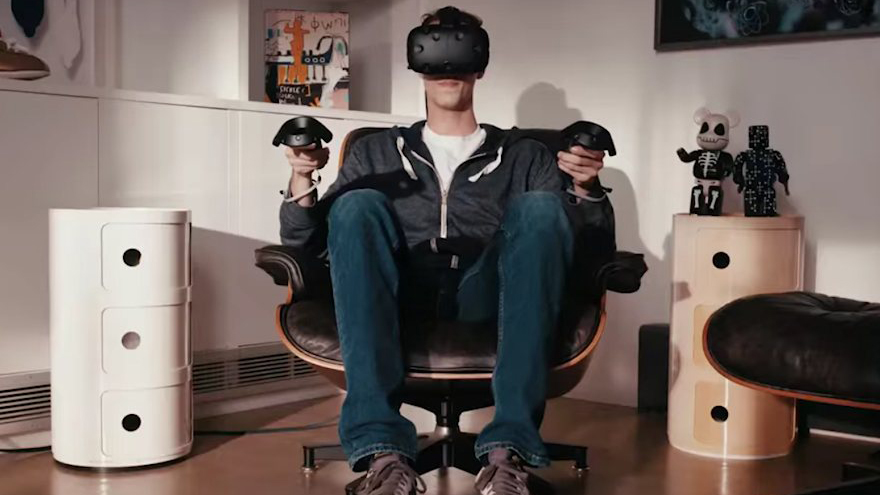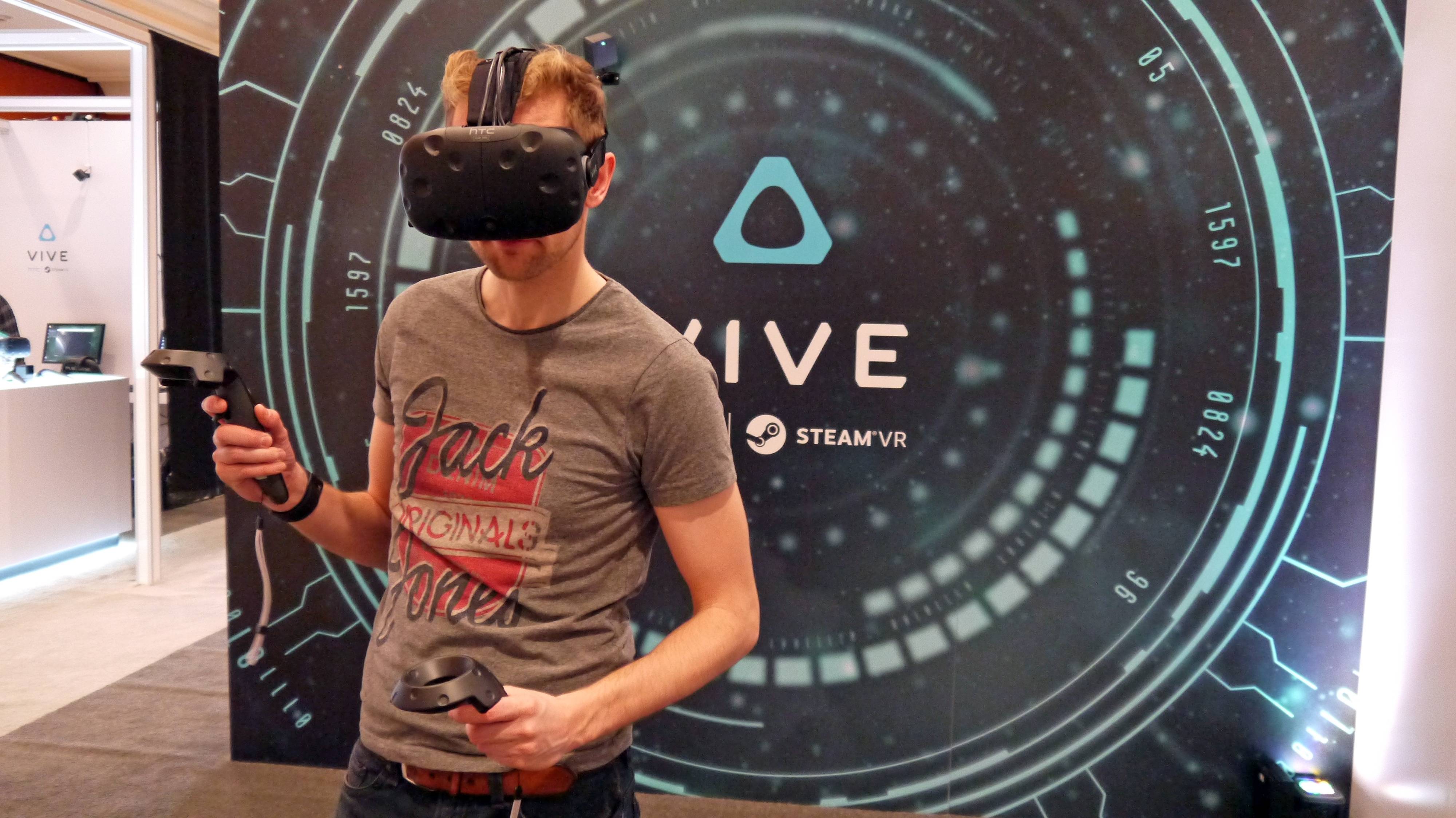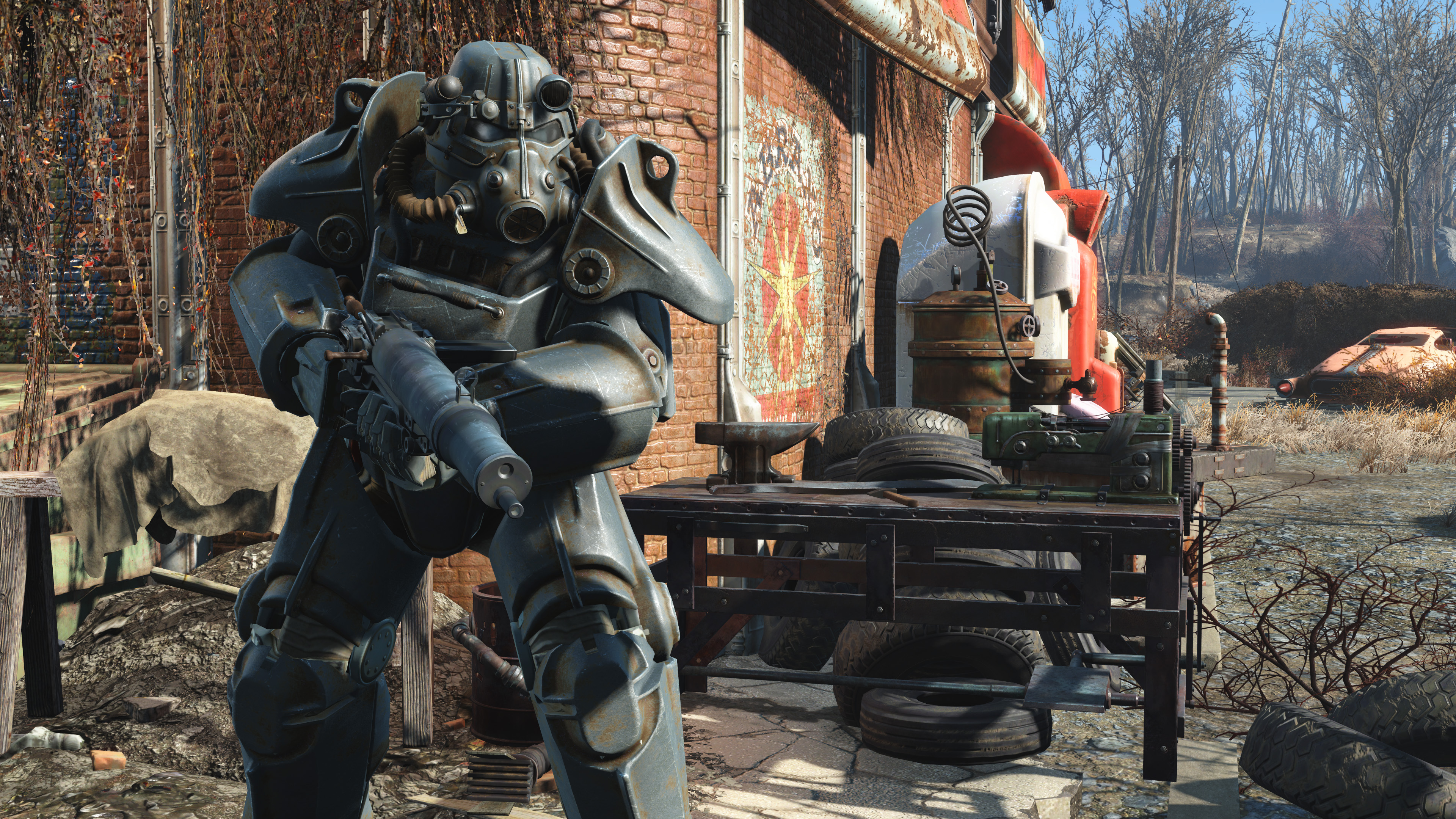AMD talks the future of VR: movement, wireless and better graphics

It’s been around a year since mainstream virtual reality made it into our homes courtesy of HTC Vive and Oculus Rift, backed up by mobile devices like the Samsung Gear VR and Google Daydream View. In the background, however, one of the biggest supporters of the VR revolution has been AMD.
The maker of processors and graphics cards has recently been in the news when it acquired Nitero, a firm which specializes in wireless VR solutions – and which Valve has previously invested in.
By heavily investing in innovative virtual reality hardware that will benefit multiple platforms, it’s clear that AMD has a keen interest in the success of VR, and has some firm ideas about what the future holds.
At the recent VR World Congress (VRWC) event in Bristol, England, we caught up with Roy Taylor, Corporate VP and Head of Alliances at Radeon Technologies Group, AMD. Under him, AMD’s relations with Microsoft, Google and major games publishers and developers is managed.
He also deals with AMD’s partnerships in the VR field with film, broadcast, gaming and academic institutions, as well as platform holders such as HTC, Valve and Oculus. We were also joined by Pat Kelly and Sven Meseke, the co-founders of Nitero.

The future is wireless
AMD’s acquisition of Nitero – and the tech that it has produced – has been one of the most exciting stories concerning virtual reality for a while now, dealing with an irresistible mix of a huge, well-known corporation and genuinely innovative – and potentially game-changing – hardware.
Roy Taylor agrees. “It’s very exciting, and the wireless technology can be very, very impactful in terms of the future of VR. We put up with wires today because we have to, in order to have the experience. But the wires are an issue in two ways; one is we are always conscious they are there, so some part of our mind is always going ‘don’t trip up,' or ‘don’t pull it out of the wall.' And that is the enemy of presence.”
Sign up for breaking news, reviews, opinion, top tech deals, and more.
"Wireless technology can be very, very impactful in terms of the future of VR"
Roy Taylor
Presence is that holy grail of virtual reality which helps people truly believe that they are present in a VR world. Anything that removes that – such as getting tangled in wires – can destroy that sometimes fragile illusion.
“The second thing is the enemy of movement," Taylor continues. “You can only move to a certain degree when you’re connected with wires. When you take that away, we feel more willing, less inhibited, to kind of roll and move and dance and so on. So, for example, you wouldn’t dance… or maybe you would, but it would be uncomfortable.”
Always wanted to strut your stuff on a VR dance floor? Wireless virtual reality could make that a possibility.

The people behind the tech
But, how does this wireless tech work? Based on Kelly's response, the tech seems as if it took some out-of-box thinking.
“So, we started with a 60GHz chipset with integrated beamforming … this produces very focused beams in the 60GHz spectrum – and the nice thing about 60GHz is that there’s nothing else there," Kelly says. "So if you’re in a room and you have Wi-Fi blasting it doesn’t matter, there’ll be no interference.”
For Kelly and the team at Nitero, the next step was bringing that into VR.
“We started with that, and a couple of months ago we started completely focusing on wireless VR," Kelly elaborates. "And, that’s when we were thinking, 'OK, how do you get this wireless stereoscopic video across at extremely low latencies so that the user isn’t affected?'”
Latency is an incredibly important thing to consider. If the pause between your command – such as moving your head – and the action being displayed in virtual reality is too long, it can lead to a pretty uncomfortable VR experience. For Roy Taylor and the team at AMD, this is incredibly important.
“That’s what we’re emphasising in the [VRWC] keynote," Taylor says. "It’s going to be fast, fast, superfast. Faster than you can imagine. As fast as you think it’s going to be – it’s faster than that."
“AMD are now a one-stop shop for everything you need to create the perfect VR experience.”
Roy Taylor
So, if Nitero already has the wireless technology in place for super-fast, low-latency VR video broadcasting, what does AMD bring to the table?
“If you think about a future solution which was going to need both a very strong and low power [consumption] CPU, and a powerful GPU, that also has low power draw, and a you have a memory subsystem, AMD has got about every part of the jigsaw,” Taylor explains.
AMD’s expertise in building CPU, GPU and other parts of a computer means that with Nitero’s experience in wireless VR, AMD can now offer a complete package.
“AMD are now a one-stop shop for everything you need to create the perfect VR experience," touts Taylor.

High-end or mobile VR?
At the moment, there are two main tiers to virtual reality. At the high end, there are the Oculus Rift and HTC Vive, which offer cutting edge VR experiences, though at a steep price.
There are also more affordable mobile VR devices, such as the Samsung Gear VR, that use a smartphone to drive the experience. But which one is the most exciting? For Taylor, the answer is both.
“Personally, I crave the richest, deepest, most immersive VR experience possible, but in order for VR to be successful it needs to be accessible to as many people as possible," Taylor says. "So, what I think will happen is we’ll see the market bifurcate between lower cost systems and VR experiences, which more people can get access to, but at the same time there’s going to be another set of people that are gonna want the very, very best they can get.”
Does this second group of people need to have an all-powerful gaming rig and expensive headset? Not necessarily.
“It can either be in people's home for super enthusiasts who can afford those systems,” Taylor explains, “or through location-based experiences, where ticket sales will mean that the location owner can invest in richer experiences for their customers.”
Meanwhile, although the high-end VR market is already giving us some impressive experiences, what the future holds is also incredibly exciting.
“Think of the opening in the film Gladiator.” Taylor continues. “You know, we are going to be able to reproduce an environment where you could be one of 60,000, or one of 100,000, troops.”
This could be a real generational leap over the games we have at the moment.
“It’s interesting, when you think about games," Taylor ponders, "you’re either the lone wolf superhero battling against hordes of AI, or you’re in a small squad.”
The future of VR, thanks to the hardware improvements the likes of AMD are working on, could soon change all that.
“There’s no current VR experience that could put you in the middle of a massive battle," Taylor admits. "Put you in the shield wall against the Vikings, or something like that. We’re going to be able to do that in the near future, and it’s going to be really exciting – and terrifying!”
It’s not just about the graphical fidelity of games that will improve, but the whole nature and usability of VR is set to change, as Pat Kelly points out, thanks to wireless VR.
“Imagine you have your mobile headset, right, and you’re walking around, you’re in a car, you’re on the bus or whatever," Kelly describes. "You come back home and you have an AMD CPU, GPU, in your PC, and with wireless technology you can actually access that power, where you can’t if you have a tethered system. So, we’re really excited at Nitero and now AMD for all types of VR.”

Light and powerful
Having a headset that is both light and mobile for when you’re out and about, yet can utilize more powerful hardware when you’re at home, is certainly very exciting, and could blur that distinction between mobile and high-end virtual reality.
So, could we see mobile VR headsets that offload the processing and graphical computing into a computer, so that we get a headset that is both powerful and light?
According to Kelly, “that’s certainly one way it could go.”
Taylor agrees that making headsets comfortable is one of the most important things to consider.
“If we’re going to put you in a prolonged experience, like with Fallout VR, or any of the things we’ve been talking about, that headset needs to be light and comfortable," Taylor says. "Certainly, we need to solve the ‘pony tail’ problem [with wires coming out of the back of a headset], as I mentioned. There are better designs coming that will do all of those things.”
And, as Sven Meseke points out, this has applications beyond VR.
”So, that use case can be translated into augmented reality in an interesting way," Meseke says. "Imagine riding your bicycle to your office in the morning, and you have your AR glasses on, with very limited GPU abilities, but while you’re riding your bicycle you just need some traffic information and message alerts, but you’re really focused on riding. You get to the office, you open up your laptop and now you have an AMD GPU in there, and thanks to the wireless connection you have full-fledged AR or mixed reality”.
"This is the time right now for Nitero to come into AMD’s fold. It’s going to be awesome.”
Sven Meseke
By that logic, could wireless VR/AR replace monitors? In Meseke’s vision of the future, it would appear so.
“You have your laptop open, you bring up Excel and open up your expense report and it’s done really quickly," Meseke predicts. "So, wireless technology combined with graphics and processing, it really makes sense to bring these together in time to market, not just for VR but for AR. As Roy says, look at three years from now, what are we going to be doing. This is the time right now for Nitero to come into AMD’s fold. It’s going to be awesome.”
So, will we be seeing the fruits of AMD and Nitero’s collaboration in three year’s time?
With a cheeky glint in his eye, Taylor responds with, “Oh, I think we’ll see something sooner than that.”
A tantalizing answer, but when we push him for any more info, he gives a vague – but great sounding – answer. “It will be sooner than you think, but not as fast as you’d like.”
Of course, for AMD’s vision of a next generation VR headset to be realized, it needs to talk to the platform holders and games developers as well. For Roy Taylor, this is his bread and butter.
“We’re talking to all the players you would expect us to be talking to."
However, it is at places like VRWC where new relationships can be forged.
“Part of doing events like this is that we’re also interested in the companies we don’t know. That we haven’t met," Taylor says. "The guy and the girl working in their garages on some great breakthrough idea. Somebody at university working in a lab. We want to find those guys, too.”
Being able to talk to those unknown players is a key benefit for Nitero, now that it has joined AMD, as Kelly points out.
“That’s a great part of the acquisition. As a startup, you couldn’t work with the folks in the garage," Kelly admits. "We just didn’t have the time, or the resources and so forth. So, it’s really great to be at AMD where they have a much broader reach and scale than we could ever hope for as a startup.”

VR World Congress
VR World Congress – where we met – is held over three days in the heart of Bristol, a vibrant city in the west of England. With 2,000 attendees, 34 exhibitors and over 100 speakers, it is quickly become the event for virtual reality.
For Roy Taylor, having Bristol host VRWC makes complete sense.
“All the GPU technology we know today was invented here. It came from David May, he invented the transputer, which was the world’s first parallel processor," Taylor reminds us. "He came out of Bristol University, then formed a company named Inmos, and that technology rolled into and became the GPU that we know today."
“So, I actually thought to myself, it’s completely apt and correct that there should be a VR event in Bristol. I think that’s really cool. We should celebrate the fact that, to some degree, you can say that the Brits invented VR. Well, we already invented the internet! Now we can say we invented VR.”
"We should celebrate the fact that, to some degree, you can say that the Brits invented VR"
Roy Taylor
Bristol, and the city of Bath just down the road, are becoming hotspots for tech companies, and in September 2017 a new collaborative VR space, the Bristol VR Lab, is opening.
This will give various companies and academic institutes a space for research, development, product design, teaching, company incubation and investment within virtual and augmented reality.
Despite it being the first time Sven Meseke has visited Bristol, he agrees that it’s an ideal location for VR innovations.
“You’ve got this rogue stuff like [the street artist] Banksy," Meseke says. "You take high tech and that kind of art together, that makes great VR.”
"Ryzen is the perfect CPU for VR.”
Roy Taylor
Investing in the future
VR headsets, especially high-end ones, are already pretty expensive. There’s a worry that going wireless could increase costs, but Pat Kelly doesn’t think so.
“We can’t really comment on the costs, but one thing to bear in mind is the cost of the cables that we’re taking away," Kelly argues. "They are very long and thin, and are only going to get more expensive as the resolution goes up. So it’s not like we’re going to be adding costs, we’re going to be taking away significant costs in the system.”
“And, you’re not stomping on a cable that will eventually wear out, right? That you’ll need to replace,” Meseke adds.
So, it could be that wireless VR won’t cost as much as we feared.
“Moore’s Law will take care of the costs,” suggests Taylor.
The scale that AMD operates at also has the potential to keep costs down, as Kelly suggests.
“AMD knows how to produce chips and get them out the door, in a large scale. Again that’s another thing that attracted us to the acquisition.”
Of course, AMD isn’t new to VR, and with its recent Ryzen processors, and upcoming Vega GPU technology, it has been laying the foundations for tech that can bring us immersive VR.

As Taylor explains, “that’s why I pushed for more [processing] cores. We need more stuff in scenes. More people, more objects, more bows, more arrows, more explosions, more trees. We always want more stuff, our real world is full of stuff. Cores and threads help. No question, you can draw more entities with the graphics card, and then render them, if you’ve got more cores and threads. So, that made Ryzen the perfect CPU for VR.”
“More, more, more, faster, faster, faster,” interjects Meseke. “It’s putting a lot of pressure on AMD. It’s a pretty bold move. Now it makes a little more sense, right? You take processing, graphics, and wireless. These are all things VR needs more of. AMD can now get it all done together. We’ve already done it with CPU and GPU, let’s keep it up with wireless.”
"Fallout VR will definitely mark the turning point.. It’s going to be a real game changer.”
Roy Taylor
The next big thing for VR
So, what does AMD see as the next big thing in virtual reality? Taylor is quick to answer.
“Fallout VR will definitely mark the turning point, no question in my mind. I’ve played it, I’m fortunate to have access to it at Bethesda. It’s superb," Taylor gushes." "It’s going to be a real game changer.”
Taylor wasn’t able to tell us any more about Fallout VR, but seeing as we love the Fallout series, we’re definitely looking forward to finding out more in due course.
“I also think another important thing is movement,” continues Taylor. “I can’t emphasize that enough. In a normal game engine, traditional movement systems in VR don’t work so well. They can tend to make you feel a little queasy. That’s why a lot of people use teleporting. But, with teleporting, you lose your sense of presence. So, I think fluid locomotion is a big deal.”

It's about more than games
Of course, it’s not just gaming where virtual reality’s future lies. The wider applications of next-gen VR are particularly exciting, as Taylor explains.
“We’re already seeing VR being used extensively in medicine. Soon, we’ll see it being used in city design and architecture. We’ll see it being used to sell real estate, VR being used in safety training.”
Science fiction could soon become science fact.
“We’re seeing VR being used to understand space and time. We’re learning that with virtual reality, time can be distorted.”
It’s all gone a bit Doctor Who. How does it work?
“You wear a VR headset for 30 minutes and it feels like five minutes.”
To anyone who has lost an afternoon (or more) messing around in VR, this will be familiar.
Taylor continues, ”We’re just starting to learn about how that works, but it turns out that when it comes to how we understand time and space, our brains are engineered for certain visual cues. And then you get environmental cues, and in virtual reality those cues are gone, they are distorted, they’ve changed. And with those cues changing, our brains are not quite sure how to calculate the time.”
It seems like we’re just starting to scratch the surface of what VR is capable of, just as movie directors were learning of new ways to wow audiences during the golden age of cinema.
“We always see new technologies through the prism of the old,” says Taylor. “How could we otherwise? So, the early films looked like theater plays because that was the prism we understood. A lot of early VR looks like movies because that’s what we understand.”
It’s when we go out of our comfort zone, when we really start innovating, that VR will become remarkable.
“We’re not expanding our minds to realize that once we step through the window, the [area we can comprehend in VR] is infinite. Infinitely out, infinitely in," Taylor posits. "So, we can look at the body and say, through VR, we now know much better how the body works. What we’re not thinking about is that we can go down to the subatomic level to understand DNA strands, and redesign DNA.”
Still not excited?
Taylor continues, “At the same time, this is a media that lets us zoom out to explore black holes. And so, if you imagine an area of infinite depth, and we are actually looking at this much [indicates tiny amount] because that’s what we understand. Now we can completely redesign our thinking about depth. Not just between miles, but 10,000, hundreds of thousands of miles. Out and in.”
Once we really get a grip of virtual reality, the possibilities could be endless. “We start with a human concept about time and space, expand that … who knows what we’re going to invent?”
This kind of makes us feel a bit bad about using VR just to play games. But, as Taylor points out, VR has the ability to show us our place in the universe – and also closer to home.
“It’s an exciting time ahead. Our kids are going to grow up with a totally different idea of what ‘Earth’ means," Taylor predicts. "In Google Earth and VR, you start to think ‘why are we fighting? It doesn’t make any freaking sense. We are all actually just people on the same planet. Why do we have all these issues?' It’s just ridiculous."

Welcome to TechRadar's 3rd annual PC Gaming Week, celebrating the almighty gaming PC with in-depth interviews, previews, reviews and features all about one of the TechRadar team’s favorite pastimes. Missed a day? Check out our constantly updated hub article for all of the coverage in one place.

Matt is TechRadar's Managing Editor for Core Tech, looking after computing and mobile technology. Having written for a number of publications such as PC Plus, PC Format, T3 and Linux Format, there's no aspect of technology that Matt isn't passionate about, especially computing and PC gaming. He’s personally reviewed and used most of the laptops in our best laptops guide - and since joining TechRadar in 2014, he's reviewed over 250 laptops and computing accessories personally.